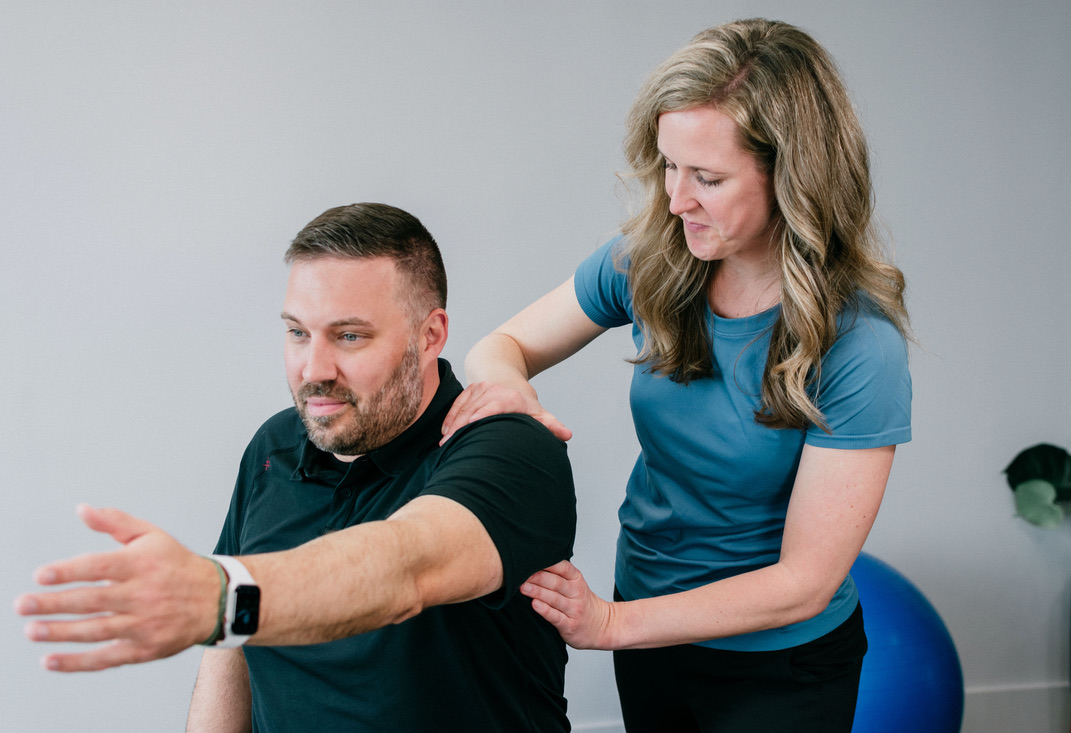Yes, blood flow restriction (BFR) training sounds a little scary to the average person. And not just scary, but most people ask “why would I ever want to restrict blood flow?” But the technique has been proven to be safe, effective, and adds an excellent boost of benefit to traditional exercise.
By definition, BFR is the brief and intermittent occlusion of arterial and venous blood flow using a tourniquet while at rest or exercising. Using this technique, you can exercise using significantly less weight but still achieve significant gains in muscle strength and size.
So what does blood flow restriction training look like?
The actual restriction of blood flow is achieved by applying a sophisticated blood pressure around your upper arm or upper leg to act as a partial tourniquet. These cuffs assess what is a safe amount of blood flow restriction so that you can get the good strength results you want without risking harm. You then complete a certain exercise regimen with these cuffs on. Most programs incorporate either light cardiovascular exercise (stationary bike, going for a walk, etc) or high repetition, low weight resistance training. Although the activity without the cuffs would be easy and considered “light,” the addition of cuffs increases the challenge quite a bit.
How does blood flow restriction work?
Blood flow restriction works by: 1) reducing the blood flow to the muscle, which decreases the amount of oxygen going to the muscle and 2) reducing the blood flow back to the heart which would carry lactic acid and other waste products. This creates a more stressful environment for the muscle and, in effect, tricks the muscle into thinking it is working harder than it actually is. There are many theories as to the exact mechanisms by which BFR training works, but research shows that it works. For example, one study showed that when using BFR training, the participants saw a 30-50% increase in muscle fiber area within the first 4-8 weeks, while a high intensity training (HIT) group of participants saw only a 15-20% increase in muscle fiber area over 12-16 weeks. The BFR acted like a shortcut to the strength gains they were hoping to achieve.
BFR training can be particularly beneficial for a number of populations.
For example, after an ACL reconstruction an athlete has to follow a very specific postoperative protocol to prevent re-injury of the ACL as it heals. Since the ligament itself can’t be loaded, the muscles around it can’t be loaded either. However, if you use BFR training, you can achieve the necessary strength gains with lighter weights and not put the ligament at risk. In addition, older individuals who have significant arthritis struggle to lift heavier weight as it puts too much stress on their joints. However, we know that strengthening surrounding muscles is the best shock absorber for the joint. Using BFR training, you would use lighter weights so as not to irritate the joint, while building much needed strength in the muscles.
Although these are a few examples, BFR can be beneficial for nearly anyone who wants to get stronger faster. There are a few contraindications and circumstances where BFR would not be appropriate, but your physical therapist is trained to screen you thoroughly to make sure using BFR is safe for you.
If you are interested in Blood Flow Restriction training or have more questions about if it’s right for you, please reach out for a free 15 minute phone consultation with Dr. Elizabeth Dalrymple!
References:
Abe T, Kearns CF, Sato Y. Muscle size and strength are increased following walk training with restricted venous blood flow from the leg muscle, Kaatsu-walk training. J Appl Physiol 100: 1460–1466, 2006.
Loenneke, J. P., Wilson, J. M., Marin, P. J., Zourdos, M. C., & Bemben, M. G. (2012). Low intensity blood flow restriction training:a meta-analysis. Eur J Appl Physiol, 112 (5), 1849-1859. doi:10.1007/s00421-011-2167-x
Takarada, Y., Tsuruta, T., & Ishii, N. (2004). Cooperative effects of exercise and occlusive stimuli on muscular function in low-intensity resistance exercise with moderate vascular occlusion. Jpn J. Physiol, 54 (6), 585-592



